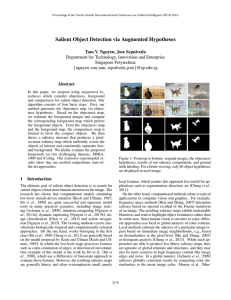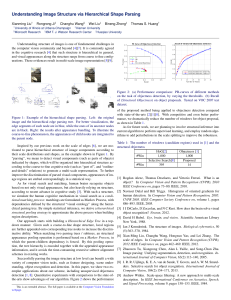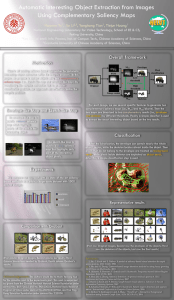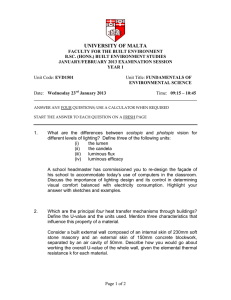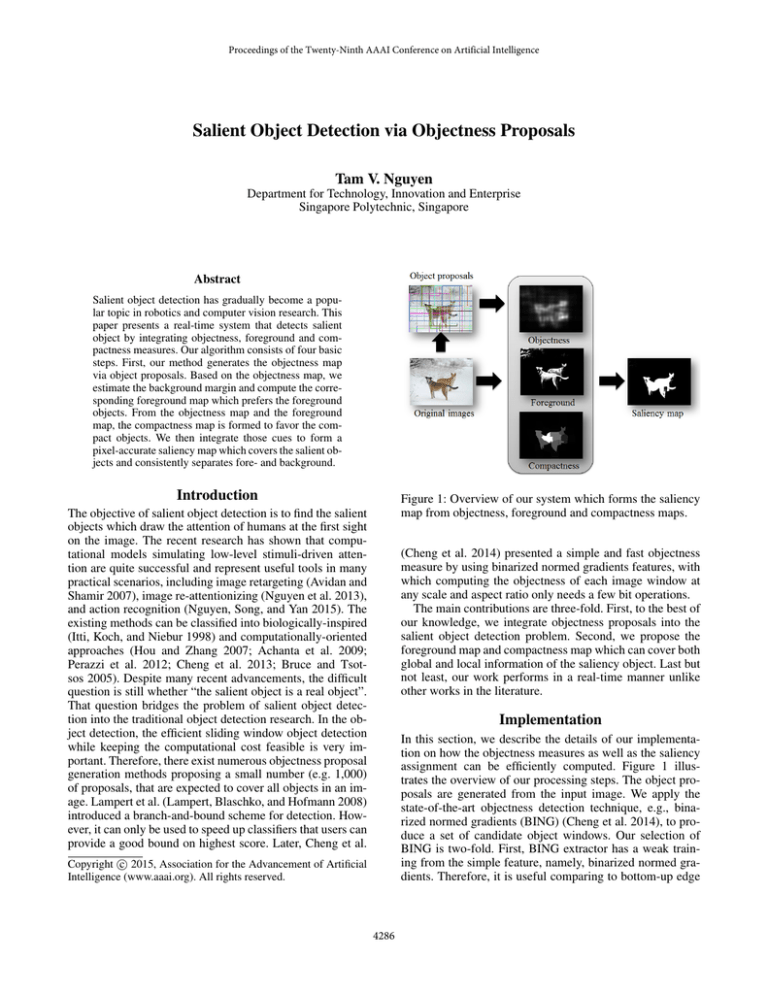
Proceedings of the Twenty-Ninth AAAI Conference on Artificial Intelligence
Salient Object Detection via Objectness Proposals
Tam V. Nguyen
Department for Technology, Innovation and Enterprise
Singapore Polytechnic, Singapore
Abstract
Salient object detection has gradually become a popular topic in robotics and computer vision research. This
paper presents a real-time system that detects salient
object by integrating objectness, foreground and compactness measures. Our algorithm consists of four basic
steps. First, our method generates the objectness map
via object proposals. Based on the objectness map, we
estimate the background margin and compute the corresponding foreground map which prefers the foreground
objects. From the objectness map and the foreground
map, the compactness map is formed to favor the compact objects. We then integrate those cues to form a
pixel-accurate saliency map which covers the salient objects and consistently separates fore- and background.
Introduction
Figure 1: Overview of our system which forms the saliency
map from objectness, foreground and compactness maps.
The objective of salient object detection is to find the salient
objects which draw the attention of humans at the first sight
on the image. The recent research has shown that computational models simulating low-level stimuli-driven attention are quite successful and represent useful tools in many
practical scenarios, including image retargeting (Avidan and
Shamir 2007), image re-attentionizing (Nguyen et al. 2013),
and action recognition (Nguyen, Song, and Yan 2015). The
existing methods can be classified into biologically-inspired
(Itti, Koch, and Niebur 1998) and computationally-oriented
approaches (Hou and Zhang 2007; Achanta et al. 2009;
Perazzi et al. 2012; Cheng et al. 2013; Bruce and Tsotsos 2005). Despite many recent advancements, the difficult
question is still whether “the salient object is a real object”.
That question bridges the problem of salient object detection into the traditional object detection research. In the object detection, the efficient sliding window object detection
while keeping the computational cost feasible is very important. Therefore, there exist numerous objectness proposal
generation methods proposing a small number (e.g. 1,000)
of proposals, that are expected to cover all objects in an image. Lampert et al. (Lampert, Blaschko, and Hofmann 2008)
introduced a branch-and-bound scheme for detection. However, it can only be used to speed up classifiers that users can
provide a good bound on highest score. Later, Cheng et al.
(Cheng et al. 2014) presented a simple and fast objectness
measure by using binarized normed gradients features, with
which computing the objectness of each image window at
any scale and aspect ratio only needs a few bit operations.
The main contributions are three-fold. First, to the best of
our knowledge, we integrate objectness proposals into the
salient object detection problem. Second, we propose the
foreground map and compactness map which can cover both
global and local information of the saliency object. Last but
not least, our work performs in a real-time manner unlike
other works in the literature.
Implementation
In this section, we describe the details of our implementation on how the objectness measures as well as the saliency
assignment can be efficiently computed. Figure 1 illustrates the overview of our processing steps. The object proposals are generated from the input image. We apply the
state-of-the-art objectness detection technique, e.g., binarized normed gradients (BING) (Cheng et al. 2014), to produce a set of candidate object windows. Our selection of
BING is two-fold. First, BING extractor has a weak training from the simple feature, namely, binarized normed gradients. Therefore, it is useful comparing to bottom-up edge
c 2015, Association for the Advancement of Artificial
Copyright Intelligence (www.aaai.org). All rights reserved.
4286
Conclusion
This paper introduces a novel method which adopts the object proposals in order to rapidly detect salient object. Our
work considers both foreground and compactness cues, leading to a reliable global and local saliency cues estimation.
Our system promises the wider integration of salient object
detection into other research works.
Acknowledgments
This work was supported by Singapore Ministry of Education under research Grant MOE2012-TIF-2-G-016.
References
Achanta, R.; Hemami, S. S.; Estrada, F. J.; and Süsstrunk, S.
2009. Frequency-tuned salient region detection. In CVPR,
1597–1604.
Achanta, R.; Shaji, A.; Smith, K.; Lucchi, A.; Fua, P.; and
Süsstrunk, S. 2012. SLIC superpixels compared to stateof-the-art superpixel methods. IEEE Trans. Pattern Anal.
Mach. Intell. 34(11):2274–2282.
Avidan, S., and Shamir, A. 2007. Seam carving for contentaware image resizing. ACM Trans. Graph. 26(3):10.
Bruce, N. D. B., and Tsotsos, J. K. 2005. Saliency based on
information maximization. In Advances in Neural Information Processing Systems 18.
Cheng, M.; Warrell, J.; Lin, W.; Zheng, S.; Vineet, V.; and
Crook, N. 2013. Efficient salient region detection with soft
image abstraction. In ICCV, 1529–1536.
Cheng, M.; Zhang, Z.; Lin, W.; and Torr, P. H. S. 2014.
BING: binarized normed gradients for objectness estimation
at 300fps. In CVPR, 3286–3293.
Everingham, M.; Gool, L. J. V.; Williams, C. K. I.; Winn,
J. M.; and Zisserman, A. 2010. The pascal visual object
classes (VOC) challenge. IJCV 88(2):303–338.
Hou, X., and Zhang, L. 2007. Saliency detection: A spectral
residual approach. In CVPR.
Itti, L.; Koch, C.; and Niebur, E. 1998. A model of saliencybased visual attention for rapid scene analysis. IEEE Trans.
Pattern Anal. Mach. Intell. 20(11):1254–1259.
Lampert, C. H.; Blaschko, M. B.; and Hofmann, T. 2008.
Beyond sliding windows: Object localization by efficient
subwindow search. In CVPR.
Nguyen, T. V.; Ni, B.; Liu, H.; Xia, W.; Luo, J.; Kankanhalli,
M. S.; and Yan, S. 2013. Image re-attentionizing. IEEE
Transactions on Multimedia 15(8):1910–1919.
Nguyen, T.; Song, Z.; and Yan, S. 2015. STAP: SpatialTemporal Attention-aware pooling for action recognition.
IEEE Trans. on Circuits and Systems for Video Technology.
Perazzi, F.; Krähenbühl, P.; Pritch, Y.; and Hornung, A.
2012. Saliency filters: Contrast based filtering for salient
region detection. In CVPR, 733–740.
Zhai, Y., and Shah, M. 2006. Visual attention detection in
video sequences using spatiotemporal cues. In ACM Multimedia, 815–824.
Figure 2: ROC curves of different methods on MSRA-1000
dataset (Achanta et al. 2009).
extractor. Second, the BING extractor is able to run 10 times
faster than real-time, i.e., 300 frames per second (fps). BING
proposal generator is trained with VOC2007 dataset (Everingham et al. 2010) same as in (Cheng et al. 2014). The objectness map is later formed by accumulating all proposals.
The foreground map is then created from the difference
between the pixel’s color and the background color obtained
following the estimated margins. We then oversegment the
image into superpixels and compute the compactness map
based on the spatial distribution of superpixels. Regarding
the image over-segmentation, we use SLIC (Achanta et al.
2012) for the superpixel segmentation. We set the number
of superpixels as 100 as a trade-off between the fine oversegmentation and the processing time. Finally, a saliency
value is assigned to each pixel by the multiplication of objectness, foreground and compactness values.
Table 1: Comparison of running times in the
mark (Achanta et al. 2009).
Method AIM
FT
SF
GC
Time (s) 62.4
0.01
0.15
0.09
Code
MATLAB C++
C++
C++
benchOurs
0.07
C++
Performance Analysis
The widely used ROC curves of our system to other works in
MSRA-1000 dataset (Achanta et al. 2009) are shown in Figure 2. Our method outperforms other state-of-the-art baselines (AIM (Bruce and Tsotsos 2005), FT (Achanta et al.
2009), GC (Cheng et al. 2013), IT (Itti, Koch, and Niebur
1998), LC (Zhai and Shah 2006), SF (Perazzi et al. 2012),
SR (Hou and Zhang 2007)) In addition, we also compare the
average running time of our approach to the currently best
performing methods on the benchmark images. The average
time is taken by each method on a PC with Intel i7 3.3 GHz
CPU and 8GB RAM. As shown in Table 1, our method obtains the fastest running times (∼15 frames per second).
4287



